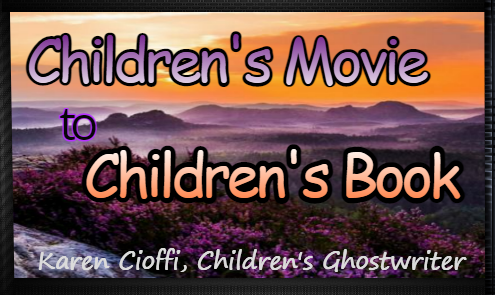While it’s usually the other way around, book to movie, if you’re a freelance writer or ghostwriter, you may get a request to turn a children’s movie into a children’s book.
If this should arise, there’s a lot to consider, especially when most non-cartoon children’s movies have multiple POVs (point-of-perspectives).
Another problem that may arise is that a movie can have more than one protagonist. Think of the Little Rascals. Choosing between Spanky and Alfalfa would be tough.
You can watch this trailer to see what I mean:
You have Alfalfa’s POV and also Spanky’s POV.
Or, you may have a movie with bad guys, and they have scenes in which they discuss things the protagonist isn’t aware of.
So, what do you do?
The first thing is to talk to the client and determine what type of POV he wants:
1. First person – The protagonist tells the story himself:
I woke, and the most enormous gorilla I had ever seen stood at the other end of my bed.
2. Third person point of view, limited – The narrator tells the story through the protagonist’s POV, but “he” and “she” are used:
Dave woke, and the biggest gorilla he’d ever seen stood at the other end of his bed.
3. Third person point of view, multiple – The narrator still uses “he” and “she,” but now the reader is privy to multiple character’s POVs. The key with this POV is to make sure your reader is aware the POV has changed in a particular scene.
I used this only once in a client’s middle-grade story. He wanted two POVs, so I took care to write it. I created new chapters for the changing POVs.
4. Third person point of view, omniscient – Again, the narrator still uses “he” or “she,” but the narrator sees all and knows all about what’s happening with every character. The narrator can also read the thoughts of any character in the story that the author chooses to expose.
If you’re writing a chapter book for ages 7-10, I would suggest convincing the client to use third person limited. Kids that young don’t need to be confused by changing POVs.
Keep in mind this will cause the most problems and work because you have to figure out how to write scenes that the protagonist isn’t aware of in the movie into scenes in the book that she’s privy to.
Usually, this isn’t too difficult to do. But if you have a movie scene that would end up being awkward to have the protagonist aware of in the book, you might consider removing that scene. You’ll have to determine how important that information is.
If it’s essential, you can relocate the scene to be somewhere the protagonist will have the opportunity to overhear the conversation or witness the action.
These are some things you’ll need to consider if you’re writing a children’s book from a children’s movie.
NEED HELP WITH YOUR CHILDREN’S STORY?
I’m a working children’s ghostwriter, rewriter, editor, and coach. I can help turn your story into a book you’ll be proud to be the author of, one that’s publishable and marketable.
OTHER HELP I OFFER:
HOW TO WRITE A CHILDREN'S FICTION BOOK
A DIY book to help you write your own children’s book.
PICTURE BOOK, CHAPTER BOOK, MIDDLE GRADE COACHING
Four to twelve-week coaching programs.
WRITERS ON THE MOVE SELF-PUBLISHING HELP
Self-publishing help for children’s authors.
Make Success a Habit with 3 Doable Steps
Villain or Antagonist – Is There a Difference?
Writing a Publishable Children’s Story: 12 Power-Tips


